
Downingia bella, also known as Hoover's calicoflower or Hoover's Downingia, is a member of the Bellflower Family (Campanulaceae). The genus is named after A.J. Downing (1815–1852) a noted American horticulturist and landscape architect.

Downingia is a genus of 13 annual plants native to western North America and Chile. Commonly known as calico flowers, they are notable for forming mass displays of small but colorful blooms around vernal pools. A number are uncommon endemics in California.
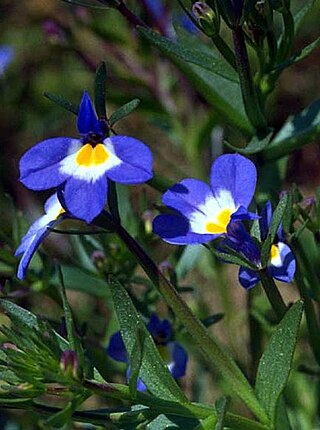
Downingia yina is a distinctive, colorful wildflower known by the common name Cascade calico-flower. It bears small, easily recognizable flowers up to 1 centimeter in width. Each flower has three fused lower petals which are blue or violet with a central spot which is white with a yellow center. This pattern is attractive to pollinating insects and helps them navigate to the flower's center. The two upper blue petals may fold together to face each other, or stick straight out.

Downingia bacigalupii is a species of flowering plant in the bellflower family (Campanulaceae) known by the common name Bach's calicoflower or Bacigalupi's downingia. This showy wildflower is native to the western United States from California to Idaho, where it is a resident of moist meadows and vernal pool ecosystems. This annual grows on a branching erect stem with small diamond-shaped leaves at intervals. At the top of each stem branch is one or more flowers, each between one and two centimeters wide. The flower has two long upper lobes which may be flat and straight or curl back, and are usually dark-veined blue. The three lower lobes are fused into one three-toothed surface, which is dark-veined blue with two bright yellow blotches rimmed with white in the center. The fruit is a dehiscent capsule two to five centimeters long. The stamens are fused together into an erect purple stalk bearing the dark anthers.
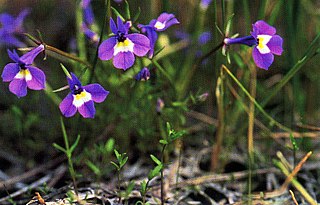
Downingia bicornuta is a species of flowering plant in the bellflower family known by the common name doublehorn calicoflower and double-horned downingia. This showy wildflower is native to the western United States from California to Idaho, where it is a resident of lakesides and vernal pool ecosystems.

Downingia concolor is a species of flowering plant in the bellflower family known by the common names maroonspot calicoflower and fringed downingia. This showy wildflower is endemic to California, where it is a resident of ponds and vernal pool ecosystems in the northern part of the state.
Downingia cuspidata is a species of flowering plant in the bellflower family known by the common name toothed calicoflower. This showy wildflower is native to California, where it is a resident of ponds, meadows, and vernal pool ecosystems throughout the state. Its range may extend into Mexico.
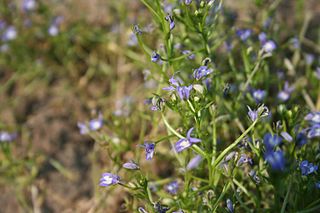
Downingia elegans is a species of flowering plants in the bellflower family known by the common names elegant calicoflower and Californian lobelia. This showy wildflower is native to western North America from California to British Columbia, where it is a resident of meadows and vernal pool ecosystems. This annual grows on a branching erect stem with many pointed leaves. At the top of each stem branch is one or more flowers, each one half to two centimeters wide. The tubular flower has two long, narrow, pointed upper lobes which are generally rich purple. The lower lip is fused into one three-lobed surface, which is purple with a large blotch of white in the center. The lobes may be quite pointed. There is sometimes some yellow coloration near the mouth of the tube.
Downingia insignis is a species of flowering plant in the bellflower family known by the common names harlequin calicoflower and cupped downingia. This showy wildflower is native to the western United States from California to Idaho, where it is a resident of lakesides and vernal pool ecosystems.
Downingia laeta is a species of flowering plant in the bellflower family known by the common name Great Basin calicoflower. This showy wildflower is native to western North America from California to Saskatchewan, where it is a resident of riverbanks, ponds, and vernal pool ecosystems. This annual grows on a thick erect stem with a few short, pointed leaves. Atop the stem is usually a single flower, which has an upper lip made up of two narrow, pointed lobes in shades of very light blue or purple, or white, and a lower lip which is a fusion of three lobes in the same color with two bright yellow spots and sometimes some purple or pink blotches or streaking.
Downingia montana is a species of flowering plant in the bellflower family known by the common name Sierra calicoflower. This showy wildflower is native to California, where it lives in the meadows and pine forests of the high mountains. Its range may extend into Oregon. This annual grows an erect stem, which may branch or not, with a few sparse small, pointed leaves. Atop the stem is usually one tubular flower. The upper lip is made up of two narrow, pointed lobes usually a shade of lavender, and the lower lip is the same color, with a central field of white and two prominent projections which may be colored yellow and dark purple. The lower lip has three lobes, each of which may have a tooth. The fruit is a capsule one to four centimeters long.
Downingia ornatissima is a species of flowering plant in the bellflower family known by the common name folded calicoflower. This showy wildflower is endemic to California, where it is a resident of vernal pools and other wet places in the Central Valley. This annual grows an erect, branching stem with usually one tubular flower at the top of each branch. The flower has an upper lip made up of two narrow, pointed lobes in shades of light purple, and a lower lip made up of three lobes fused into one surface, which is the same color as the upper lip and has a central field of white with two prominent yellow projections. The flower is similar to those of other downingias, except it is lightly crinkled, with the upper lobes often curled back and the edges of the lower lobes uneven. The dark blue anther just emerges from where it is tucked between the upper lobes.
Downingia pusilla is a species of flowering plant in the bellflower family known by the common name dwarf calicoflower. This wildflower is found in two separate parts of the world, Chile and the US state of California. It grows in wet areas such as ditches and vernal pools. This annual is different from the other downingias in that its flowers are much smaller, reaching 4 millimeters in width at maximum. It grows erect stems with few pointed leaves. The tiny tubular flower is white or blue, with yellow spots near the mouth of the tube. The fruit is a capsule two or three centimeters long.

Keckiella breviflora is a species of flowering shrub in the plantain family known by the common name bush beardtongue.

Keckiella corymbosa is a species of flowering shrub in the plantain family known by the common names redwood keckiella, red beardtongue, and red shrubby penstemon.
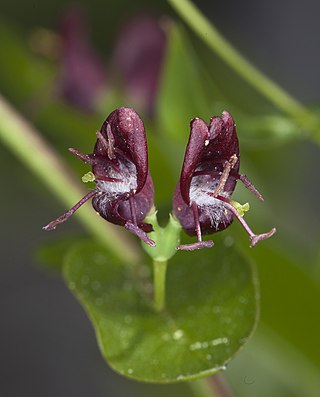
Lonicera conjugialis is a species of honeysuckle known by the common name purpleflower honeysuckle. It is native to the western United States from Pacific Northwest to the Sierra Nevada, where it grows in many types of mountain habitat, especially moist areas. This is a slender shrub often exceeding 1.5 meters in erect height. The lightly hairy leaves are oval to round and 2 to 8 centimeters long. The inflorescence is generally a pair of flowers nestled in a leaf axil toward the end of a branch. Each flower is maroon red to deep purple in color. It has an upper lip made up of four fused lobes, and a single-lobed lower lip. The protruding stamens are tipped with light-colored anthers. The fruit is a pair of bright red berries which are often fused together in a double-lobed unit.
Erythranthe glaucescens is a species of monkeyflower known by the common name shieldbract monkeyflower. It was formerly known as Mimulus glaucescens.
Nemacladus interior is a species of flowering plant in the bellflower family known by the common name Sierra threadplant. It is native to the Sierra Nevada of California, and it is known from Oregon as well. It grows in mountain forest habitat. It is an annual herb producing a stiff upright purple-brown stem up to about 25 centimeters tall. Small toothed oval leaves 1 to 2 centimeters long occur at the base of the plant. The inflorescence is a zigzagging series of branches bearing occasional flowers on thin pedicels. There is a single tiny bract at the base of each pedicel. The flower is a few millimeters long. It has five triangular sepals and five corolla lobes, three lobes on the upper lip and two on the lower. The corolla is white to pale purple or pink with a thin red band and yellow spot at the base of each lobe.

Porterella is a monotypic genus of flowering plants in the bellflower family containing the single species Porterella carnosula, which is known by the common name fleshy porterella, or simply porterella.
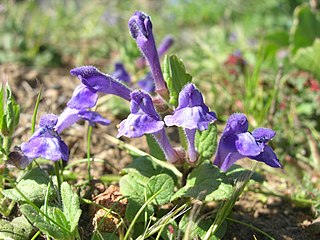
Scutellaria tuberosa is a species of flowering plant in the mint family known by the common name Danny's skullcap. It is native to western North America from Oregon through California to Baja California, where it is widespread throughout the mountain and coastal regions; it is absent from the deserts and the Central Valley of California. It can be found in forest and woodland habitat, and a variety of open habitat types, often appearing in areas recently cleared by wildfire. It is a perennial herb producing an erect stem or cluster of stems up to about 25 centimeters tall from a root system with tubers. The stems are coated in short, spreading hairs. The oval leaves are oppositely arranged. The lowest leaves are borne on short petioles. Flowers emerge from the leaf axils. Each flower is held in a calyx of sepals with a large ridge or dome-shaped appendage on the upper part. The tubular corolla is one to two centimeters long and has a large upper and lower lip. The upper lip is folded into a beaklike protrusion and the lower has three wide lobes. The corolla is deep purple-blue, usually with a white patch or mottling on the lower lip.











